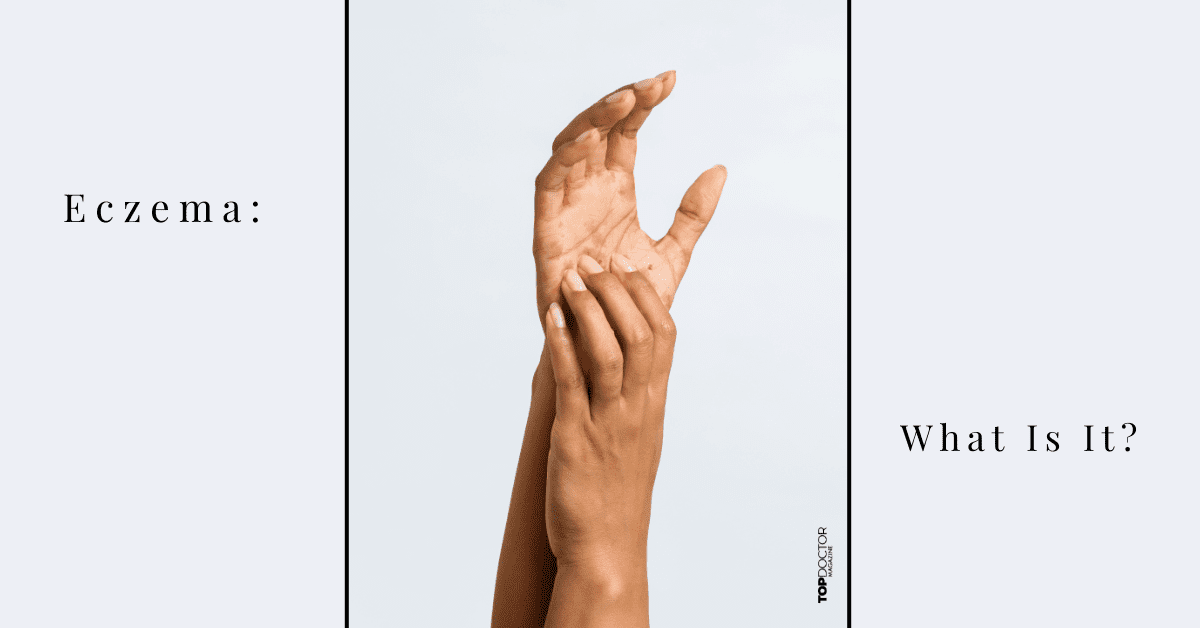Eczema: What Is It?
Eczema, also called atopic dermatitis, is a condition that causes your skin to blister and become itchy, dry and full of rashes. The symptoms depend on the type of eczema you are experiencing. This skin infection is widespread in children (i.e., infantile eczema and childhood eczema), especially those going through puberty. But this does not mean adults are safe from eczema.
An important detail of eczema is that it is chronic, meaning it can last for lengthy periods. In addition, eczema can have different stages of magnitude, named by the people with this skin condition as ‘flare-ups.’ Usually, flare-ups erupt in unexpected moments, but specific triggers can speed it up.
Types of Eczema
Eczema is very well known for the variety of types it presents. Each eczema type comes with a set of symptoms to help you identify it.
Atopic Dermatitis
Atopic dermatitis is the most common type of eczema. It is mainly seen in children and can be mild or severe. Parents can hand down atopic dermatitis to children through DNA. Children with atopic dermatitis are more likely to develop food sensitivity, hay fever or asthma.
Symptoms of atopic dermatitis include itchy and inflamed skin and redness. This type of eczema usually appears on the knees, neck, creases of the elbows, wrists and facial skin.
Cold weather, low humidity, detergents, soaps, perfume, animal hair or saliva, scabies, dust, wool, synthetics, food allergies and hormonal changes can trigger severe atopic dermatitis flare-ups.
Contact Dermatitis
Contact dermatitis appears when your skin comes in contact with certain substances. As a result, the skin patch becomes red, dry and itchy. It can also blister very quickly and turn into a hive, a type of rash resembling small red bumps.
This type of eczema increases its chance of appearing if you already suffer from atopic dermatitis. Contact dermatitis can either be irritant or allergic. Irritant contact dermatitis appears when your skin comes in contact with substances that irritate the skin, such as:
- Solvents;
- Cement;
- Weed killers;
- Acids and alkalis;
- Hair dyes;
- Different types of shampoo;
- Fabric softeners and harsh detergents.
Allergic contact dermatitis develops when a person’s immune system considers particular substances as allergens. Usually, once the body deems a substance an allergen, you will be allergic to it. Examples of possible allergens are:
- Latex;
- Fabrics and clothing dyes;
- Glue and adhesive;
- Plants like sumac, poison oak and poison ivy;
- Medications such as oral antibiotics and topical;
- Makeup and different cosmetics;
- Nail polish.
Neurodermatitis
Neurodermatitis is a more severe eczema type. It manifests itself by developing itchy patches on your skin that become itchier and itchier with each scratch. Repeatedly scratching the skin patch causes it to become thick and leathery. The scratching cycle can disrupt your sleep schedule, sexual drive and general quality of life. Neurodermatitis usually develops on the wrists, legs, neck, forearms and anal region.
Dyshidrotic Eczema
Dyshidrotic eczema, also known as pompholyx eczema, is a skin condition that usually appears in people under 40 years old. It manifests itself by spreading small blisters all over the hands and feet, becoming incredibly itchy, filling with liquid and turning infectious. In addition, the blisters can become very painful as they swell up and ooze pus.
It has not been discovered what causes dyshidrotic eczema to develop, but it is more common in people experiencing hay fever, fungal skin infections and atopic dermatitis. In addition, it can sometimes be triggered by emotional stress and drastic weather changes.
Nummular Eczema
Nummular eczema, also known as discoid eczema, is easily recognized because of the circular-shaped patches of itchy, red and swollen skin that it causes. This type of eczema usually affects the lower legs, forearms and torso. Nummular eczema can be triggered by:
- Cold weather;
- Bacterial skin infections;
- Insect bites;
- Dry skin;
- Injuries such as burns, friction and slashes;
- Certain medication;
- Atopic dermatitis.
Seborrheic Dermatitis
Seborrheic dermatitis is the only type of eczema that mainly affects your scalp. It manifests itself through scaly patches, red skin and dandruff spreading on your scalp and face. It can also affect oily parts of the body such as the sides of the nose, eyebrows, eyelids, ears and chest. The main seborrheic dermatitis triggers are:
- Certain medications;
- Weak immune system;
- Illnesses such as (e.g., HIV, AIDS and cancer) and alcoholic pancreatitis;
- Going through an arduous recovery, especially from a heart attack.
Stasis Dermatitis
Stasis dermatitis is the type of eczema that usually spreads around the lower legs. The main cause of stasis dermatitis is a condition called chronic edema. Chronic edema is the swelling caused by excess fluid in the body tissue. Stasis dermatitis turns the skin around your lower leg red and very itchy. It can also lead to more dangerous symptoms such as hyperpigmentation, pus and lichenification.
Eczema Symptoms
Eczema varies in the types and symptoms you can experience. Usually, each type of eczema has different symptoms to help you identify it. But, even with all of these types, there are a few symptoms of eczema experienced through each of them, such as:
- Itching;
- Dry skin;
- Sensitive skin;
- Swelling;
- Oozing;
- Crusting of the skin;
- Inflammation;
- Discoloration of the skin patch;
- Lathery or scaly skin patches.
Body Areas Predisposed to Eczema
The affected skin areas vary because so many types of eczema are different in how they manifest and the areas they affect. Most types of eczema affect the face, neck, wrists and hands, but they can also spread on your legs, feet, scalp and anal region.
How Often Does Eczema Flare Up?
Three things can be said about eczema flare-ups: they are occasional, chaotic and triggered by different factors. If you think you have figured out what causes your eczema flare-ups, you can diminish them by keeping your distance from triggers.
Eczema Versus Psoriasis
Psoriasis is a skin disease that manifests itself similarly to eczema. However, there are ways to tell them apart. Eczema causes such intense itchiness that you can start bleeding if you can’t avoid scratching. The skin patch turns red, inflamed, crusty and can scale and ooze.
On the other hand, psoriasis also causes itchy skin, but the skin also stings and burns. Psoriasis also causes red patches of skin, but the patches are much thicker and more inflamed than eczema.
Eczema Versus Hives
Hives, also known as urticaria, are an allergic reaction to factors your body considers allergens. A significant difference between eczema and hives is that eczema turns the patch of skin very dry and leathery, while hives only cause large bumps to appear without any fluid.
Eczema Versus Rosacea
Rosacea is a skin condition that also causes redness, itching and bumps to appear on the skin. It’s challenging to tell eczema and rosacea apart, but you will find differences if you pay close attention to the details. For example, eczema does not cause flushing of the skin or make your blood vessels more visible, such as rosacea.
Eczema Versus Shingles
Both skin conditions cause the skin to become inflamed, itchy and somewhat painful. Shingles are considered to be herpes caused by a virus named varicella-zoster virus. Specific differences between the two conditions are:
- Rashes caused by shingles appear on only one side of the body, while the rash caused by eczema spreads on both sides.
- Shingles cause burning and tingling before the rash appears;
- Shingles cause fatigue;
- Shingles usually disappear after a few weeks, while eczema is chronic.
Eczema during Pregnancy
Experiencing eczema during pregnancy will not put a pregnant woman or her fetus in danger. But, because it’s a chronic condition, eczema can continue even after pregnancy. So, if you would like to follow up on treatment for eczema during pregnancy, talk to your doctor first, as they can prescribe you a treatment that won’t put you or the child in danger.
Can Eczema Cause Hair Loss?
Only seborrheic dermatitis can cause hair loss if left untreated. This happens because the hair finds it difficult to grow through an unhealthy and inflamed scalp. Also, people with seborrheic dermatitis tend to scratch their scalp, leading to hair loss.
Facial Eczema Treatments
Because eczema is persistent, you may need to try various treatments over a long period until you find something that genuinely controls the skin condition. But this does not mean that it will genuinely disappear and that the flare-ups will stop. The most common treatment modalities are:
- Topical treatments such as creams and mild soaps to stop the itching and repair the skin;
- Prescription medications that fight the infection and control the inflammation;
- Therapies such as wet dressings, counseling and light therapy;
- Behavior modification to stop scratching yourself.
Eczema Foods to Avoid
Since people with eczema have different triggers and allergens, it’s hard to put your finger on eczema-related foods. You first have to determine which foods are causing the skin reaction and flare-ups. When you find that the eczema symptoms worsen after eating a particular type of food, it’s time to remove it from your diet. The most common foods that trigger eczema and eczema flare-up are:
- Dairy;
- Eggs;
- Soy;
- Gluten;
- Wealth;
- Citrus fruits;
- Nuts;
- Spices;
- Tomatoes;
- Pears.
Can Eczema Be Cured?
Unfortunately, there is no absolute cure for this skin condition because eczema is chronic. Some treatments can diminish the eczema symptoms and even stop them for weeks, but there is no cure.
A Parting Reminder
If you think you may suffer from eczema, it’s essential to consult a doctor or dermatologist since this condition can become dangerous if left untreated. However, you can live a happy and healthy life with proper treatment modalities, even if your eczema will never truly vanish.






0 Comments